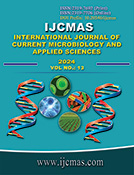


 National Academy of Agricultural Sciences (NAAS)
National Academy of Agricultural Sciences (NAAS)

|
PRINT ISSN : 2319-7692
Online ISSN : 2319-7706 Issues : 12 per year Publisher : Excellent Publishers Email : editorijcmas@gmail.com / submit@ijcmas.com Editor-in-chief: Dr.M.Prakash Index Copernicus ICV 2018: 95.39 NAAS RATING 2020: 5.38 |
Bakery food products encompass a wide variety of items, ranging from traditional bread and pastries to innovative and specialty baked goods. Bakeries worldwide craft these products using a combination of basic ingredients such as flour, sugar, yeast, eggs, and butter, but the creativity of bakers often results in a diverse and delicious array of offerings. Contamination of bakery products with fungi is a serious concern, as it poses health risks to consumers. Fungi, including molds, can produce mycotoxins that are harmful if ingested. If you suspect that bakery products are contaminated with fungi, it's crucial to address the issue promptly. This research aims to investigate the aflatoxigenic potential of Aspergillus flavus in bakery samples using the UV light and ammonia vapor test. By employing this innovative methodology, we seek to streamline the detection process, providing a rapid and reliable means of identifying aflatoxin-producing strains. The findings of this study hold the potential to enhance food safety protocols in the baking industry, contributing to the production of uncontaminated and healthful bakery products. The results indicate that 35% of A.flavus isolates were aflatoxigenic, and proper handling and sanitation are emphasized to prevent spoilage and contamination of bakery products.
Abellana M, sanchis U. and Ramos A J. Effect of water activity and temperature on growth of three Penicillium Sp. and Aspergillus flavus on a spongy cake analogue. International Journal of Food Microbiology, 1996.71: 3151-3157. https://doi.org/10.1016/s0168-1605(01)00596-7
Raed Najeeb Alkhersan, Mohammed H.Khudor, Basil A. Abbas. 2016. Rapid detection of aflatoxigenic producing atrains of Aspergillus flavus from poultry fees by uv light and Ammonia Bas.J.Vet.Res.15(4): 169-178.
Bailey C P. and Holy A V. Bacillus spore contamination associated with commercial bread manufacture, Food Microbiology, 1993. 10: 287- 294.
Bartkiene E G, Juobeikiene and Vidmantiene D. Evolution of deoxynivalenol in wheat by acoustic method and impact of starter on its concentration during wheat bread baking process. Food Chemistry and Technology, 2008. 42: 5-12.
Carla Lucian Gerez, Mariaines Torino, Prevention of bread mold spoilage by using Lactic acid bacteria with antifungal properties. Journal of Food Science, 2009. 20: 144-148. https://doi.org/10.1016/j.foodcont.2008.03.005
Davis N D, Iyer S K. and Diener U L. Improved method of screening for aflatoxin with a coconut agar medium. Appl. Environ. Microbiol. 1987.53(7):1593–1595. https://doi.org/10.1128/aem.53.7.1593-1595.1987
Domsch K H, Gams W. and Anderson T H. Compendium of soil fungi. Academic press. London, New York, Toronto, Sydney, San Francisco, 1980.1:859.
Fani ,S.R.; Moradi ,M.; Probst ,C.; Zamanizadeh, H. R.; Mirabolfathy, M. and Haidukowski,M.(2014). A critical evaluation of cultural met hods for the identification of atoxigenic Aspergillus flavus isolates for aflatoxin mitigation in pistachio orchards of Iran. Eur. J. Plant Pathol.,140(4):631-642.
Hara S, Fennell D I. and Hesseltine C W. Aflatoxin-producing strains of Aspergillus flavus detected by fluorescence of agar medium under ultraviolet light. Appl. Microbiol, 1974. 27(6):1118-1123. https://doi.org/10.1128/am.27.6.1118-1123.1974
Jarvis B. Mould spoilage of food. Process biochemistry, 2001. 7: 11-14.
Knight R A. and Menlove E M. Effect of the bread baking process of destruction of certain mould spores. Journal of the Science of Food and Agriculture, 2006. 10: 653-660.
Klich,M.A.(2002).Identification of common Aspergillus species. Centraalbureau voor Schimmel cultures, Utrecht, The Netherlands.pp:46
Malkki Y. and Rauha O. Mould inhibition by aerosols. Bakers Digest, 2000; 52: 47-50.
Marin S, Guynot M E. Sanchis. Aspergillus flavus, Aspergillus niger and Penicillium coryophilum spoilage prevention of bakery product by means of weak acid preservatives. Journal of Food, 2003.
Nair ,S. C.; Bhagobaty, R.K. ;Nmpoothiri,K.; Kalaighandhi ,V. and Menon, K.R.K. (2014). Detection of aflatoxin production by fungi in spice samples using HPLC and direct visual cultural methods. Innovative Romanian Food Biotechnology, 14, 1-12.
Yazdani, D.; Zainal Abidin, M. A.; Tan, Y. H. and Kamaruzaman, S.1(2010). Evaluation of the detection techniques of toxigenic Aspergillus isolates. Afr. J. Biotechnol., 9 (45): 7654-7659.
Zarari,T.J.O. (2013). Detection of aflatoxin from some Aspergillus ssp. isolated from wheat seeds. Journal of Life Sciences, 7 (10): 1041-1047. |
 |
 |
 |
 |